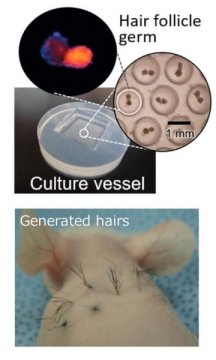Researchers have developed a method for the mass preparation of cellular aggregates, also known as ‘hair follicle germs (HFGs)’, that may lead to a new treatment for hair loss.

Culture vessel for the mass preparation of hair follicle germs (above). Generated hairs on the back of a mouse (below). Credit: Yokohama National University
Hair loss is becoming a growing problem in youth. It happens due to lack of nutrition or you may get it as an inherent present. Youth spends a hilarious amount of money to regrow hair on his skull. This seems to be a great opportunity for a business, isn’t it? It’s a billion dollar industry. Where companies like Dr. Bratras and recent TV advertisements like Bhringa oil etc. are earning a lot. As the Indian economy is growing and the middle class is getting money to spend. They are spending on grooming. A recent survey shows that in the year 2017, grooming industry including your nearby salon showed a massive 2.7 billion dollar earnings. But, all those aspirants who have tried all the means to grow hair went in vain.
Now, researchers have found a way in the cells itself to regrow hair. The cause behind the hair fall and not growing again was the lack of hair follicles, the tine organs to sustain and grow the hair. So, acting on the cause researchers have developed a therapy, which regrows hair follicles. One of the more challenging obstacles to hair regenerative medicine has been the preparation of hair follicle germs, the reproductive source of hair follicles, on a large scale.
The paper, published in the journal Biomaterials, reports the successful preparation of up to 5000 HFGs simultaneously and reports new hair growth from the HFGs after transplantation into mice.
“The key for the mass production of HFGs was a choice of substrate materials for culture vessel,” says the corresponding author Junji Fukuda, Professor, Yokohama National University. “We used oxygen-permeable dimethylpolysiloxane (PDMS) at the bottom of culture vessel, and it worked very well.”
The research group further evaluated the feasibility of this method by transferring the prepared HFGs from a fabricated approximately 300-microwell array, called “HFG chip,” to generate hair follicles and hairs on the mouse body. The group confirmed black hair generation at both the back and scalp transplantation sites. The regenerated hair exhibited the typical hair cycle of murine hair.
Journal Reference:-
- Tatsuto Kageyama, Chisa Yoshimura, Dina Myasnikova, Ken Kataoka, Tadashi Nittami, Shoji Maruo, Junji Fukuda. Spontaneous hair follicle germ (HFG) formation in vitro, enabling the large-scale production of HFGs for regenerative medicine. Biomaterials, 2018; 154: 291 DOI: 10.1016/j.biomaterials.2017.10.056
